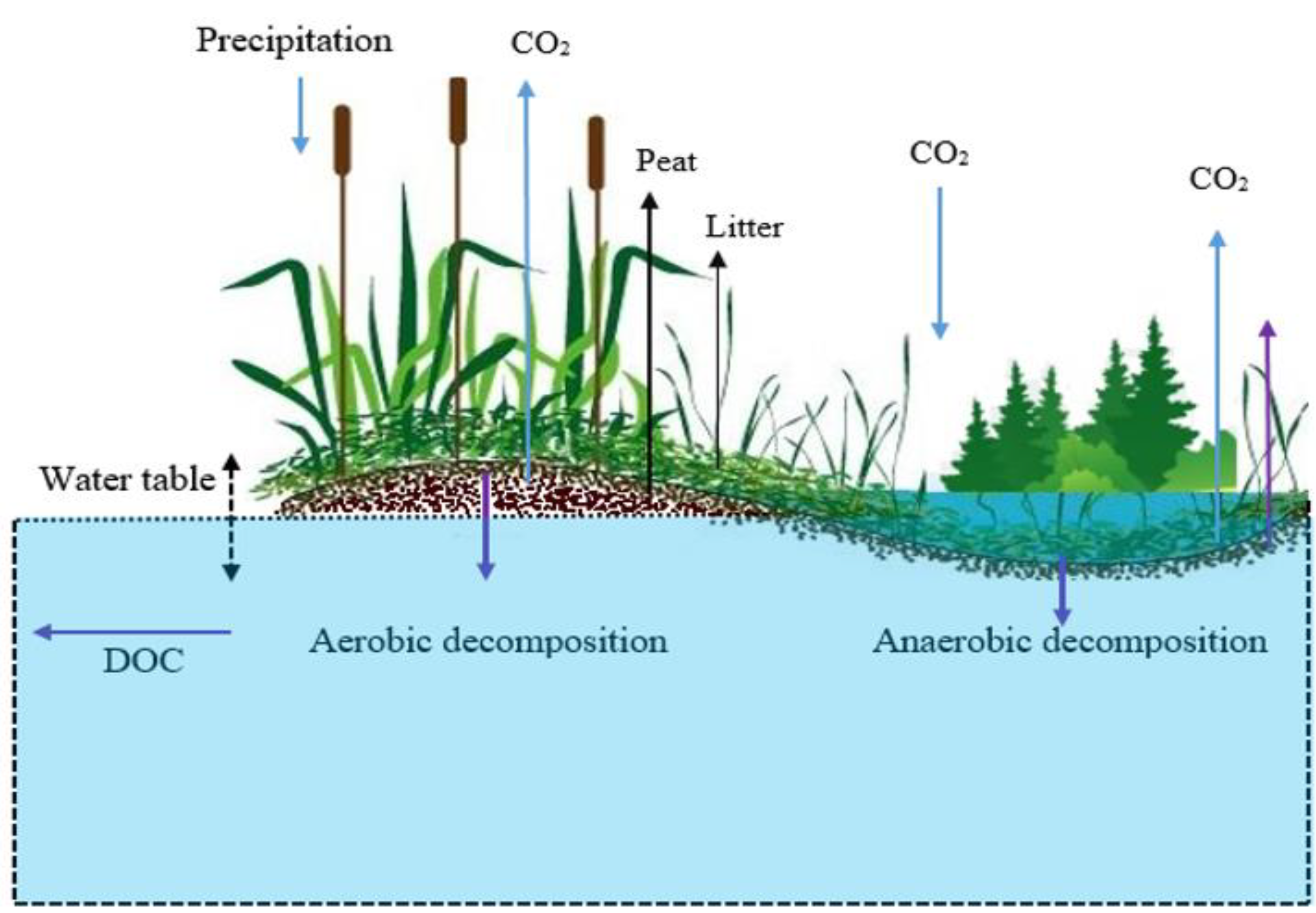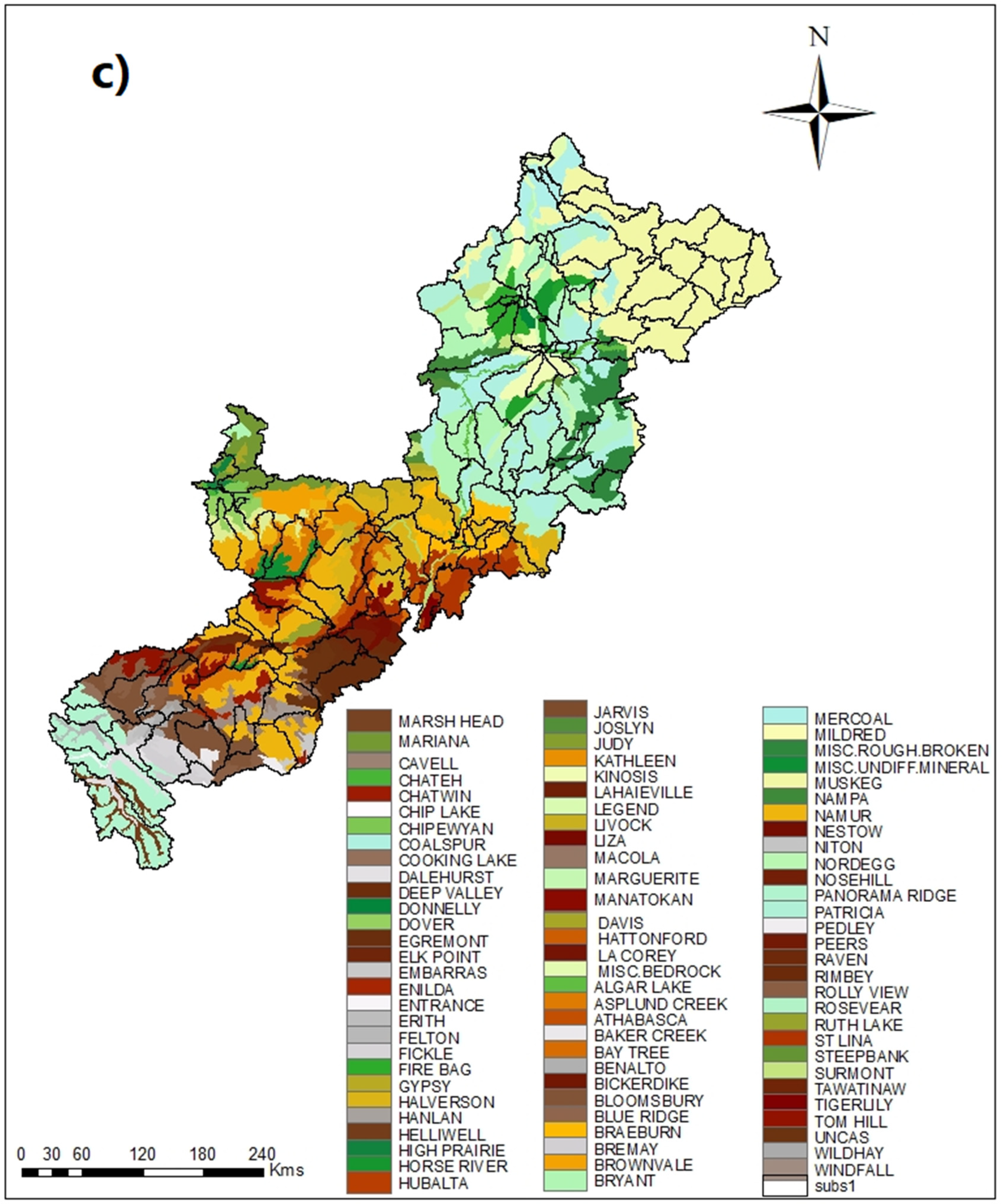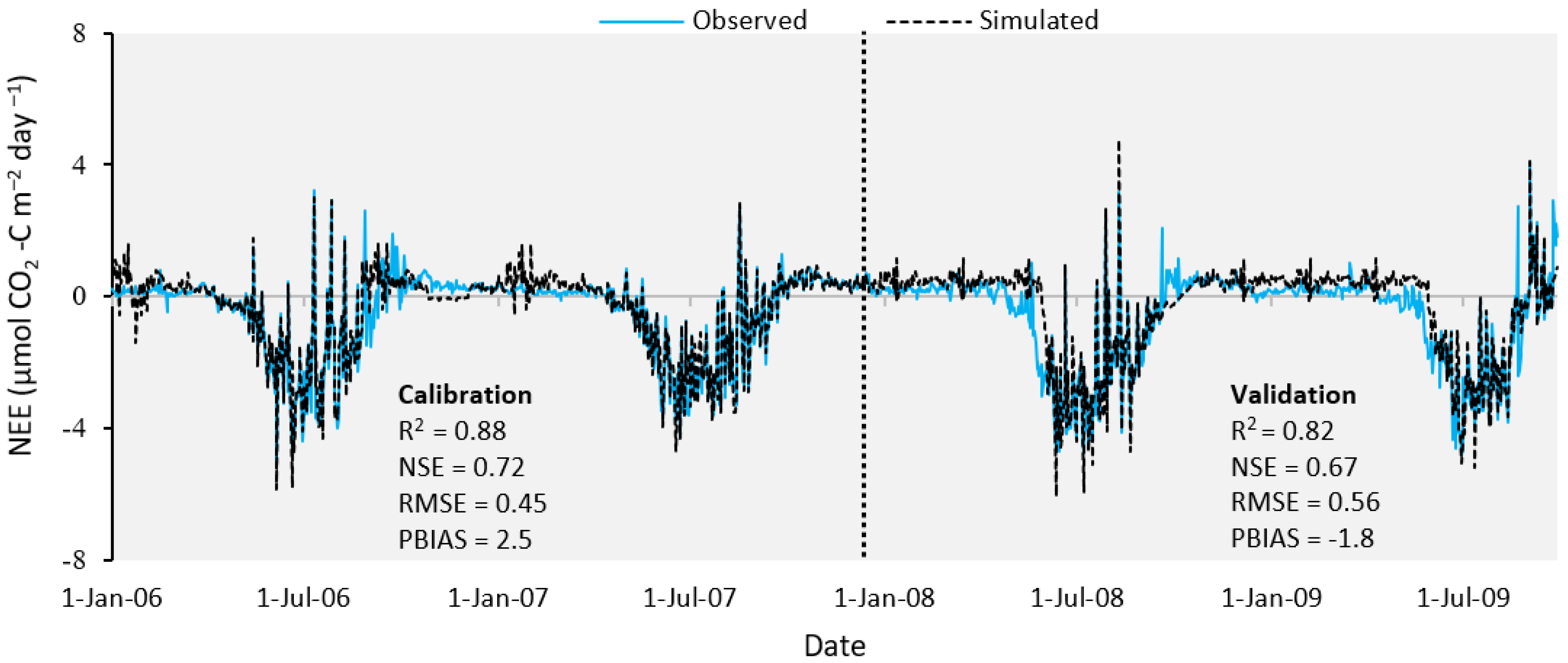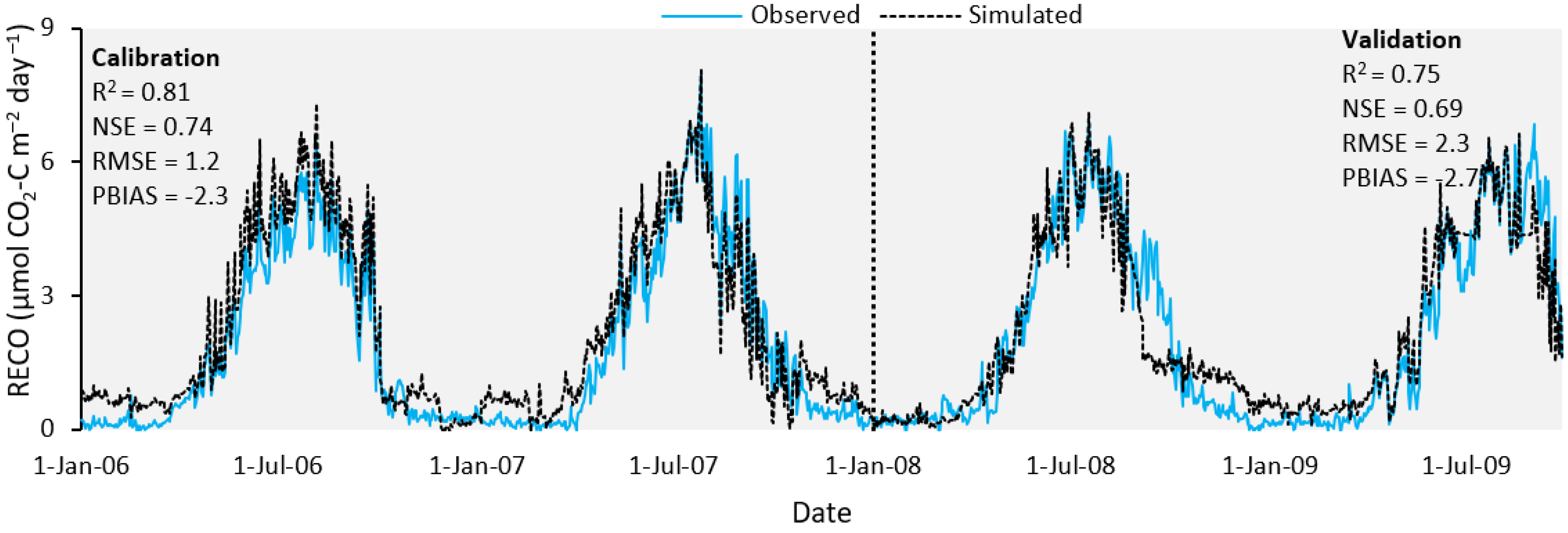Modeling the Dynamics of Carbon Dioxide Emission and Ecosystem Exchange Using a Modified SWAT Hydrologic Model in Cold Wetlands
Abstract
1. Introduction
2. Materials and Methods
2.1. Study Area
2.2. Wetland Classification
2.3. Carbon Dioxide Emission Model from Wetlands
2.4. Description of the Model
2.5. Model Inputs, Calibration, and Validation
2.6. SWAT Model Statistical Evaluation
3. Results
3.1. Model Sensitivity
3.2. Net Ecosystem Exchange (NEE)
3.3. Groundwater Table
3.4. Ecosystem Respiration
3.5. Soil Temperature
3.6. Carbon Dioxide Emission
3.7. Spatiotemporal Distribution of Carbon Dioxide Emissions
3.8. The Relationship between NEE, RECO, Soil Temperature, and CO2 Emissions
4. Discussions
4.1. Advantages of the Modified SWAT Model
4.2. Implications to Wetland Remediation and Reclamation, Limitation, and Future Research
5. Conclusions
Author Contributions
Funding
Data Availability Statement
Acknowledgments
Conflicts of Interest
References
- Gorham, E. Northern wetlands: Role in the carbon cycle and probable responses to climatic warming. Ecol. Appl. 1991, 1, 182–195. [Google Scholar] [CrossRef] [PubMed]
- Yu, Z. Holocene carbon flux histories of the world’s wetlands: Global carbon-cycle implications. Holocene 2011, 21, 761–774. [Google Scholar] [CrossRef]
- Frolking, S.E.; Bubier, J.L.; Moore, T.R.; Ball, T.; Bellisario, L.M.; Bhardwaj, A.; Carrol, P.; Crill, P.M.; Lafleur, P.M.; McCaughey, J.H.; et al. Relationship between ecosystem productivity and photosynthetically active radiation for northern wetlands. Glob. Biogeochem. Cycles 1998, 12, 115–126. [Google Scholar] [CrossRef]
- Syed, T.H.; Famiglietti, J.S.; Chen, J.; Rodell, M.; Seneviratne, S.I.; Viterbo, P.; Wilson, C.R. Total basin discharge for the Amazon and Mississippi river basins from GRACE and a land-atmosphere water balance. Geophys. Res. Lett. 2005, 32, L24404. [Google Scholar] [CrossRef]
- Blodau, C.; Moore, T.R. Experimental response of wetland carbon dynamics to a water table fluctuation. Aquat. Sci. 2003, 65, 47–62. [Google Scholar] [CrossRef]
- Humphreys, E.R.; Lafleur, P.M.; Flanagan, L.B.; Hedstrom, N.; Syed, K.H.; Glenn, A.J.; Granger, R. Summer carbon dioxide and water vapor fluxes across a range of northern wetlands. J. Geophys. Res. 2006, 111, G04011. [Google Scholar] [CrossRef]
- Kelly, R.A.; Jakeman, A.J.; Barreteau, O.; Borsuk, M.E.; ElSawah, S.; Hamilton, S.H.; Henriksen, H.J.; Kuikka, S.; Maier, H.R.; Rizzoli, A.E.; et al. Selecting among five common modelling approaches for integrated environmental assessment and management. Environ. Model. Softw. 2013, 47, 159–181. [Google Scholar] [CrossRef]
- Butterbach-Bahl, K.; Baggs, E.M.; Dannenmann, M.; Kiese, R.; Boltenstern, S.Z. Nitrous oxide emissions from soils: How well do we understand the processes and their controls? Philos. Trans. R. Soc. B 2013, 368, 20130122. [Google Scholar] [CrossRef]
- Parton, W.J.; Hartman, M.; Ojima, D.; Schimel, D. DAYCENT and its land surface sub model: Description and testing. Glob. Planet. Change 1998, 19, 35–48. [Google Scholar] [CrossRef]
- Ogle, S.M.; Parton, W.J.; Cheng, K.; Pan, G. Using the DayCent Ecosystem Model to Predict Methane Emissions from Wetland Rice Production in Support for Mitigation Efforts. In Proceedings of the American Geophysical Union, Fall Meeting, abstract id. GC14B-12. San Francisco, CA, USA, 15–19 December 2014. [Google Scholar]
- Leffelaar, P.A. Dynamics of partial anaerobiosis, denitrification, and water in a soil aggregate. Soil Sci. 1988, 146, 427–444. [Google Scholar] [CrossRef]
- Leffelaar, P.A.; Wessel, W.W. Denitrification in a homogeneous, closed system. Soil Sci. 1988, 146, 335–349. [Google Scholar] [CrossRef]
- Li, C.; Frolking, S.; Crocker, G.J.; Grace, P.R.; Klír, J.; Korchens, M.; Poulton, P.R. Simulating trends in soil organic carbon in long-term experiments using the DNDC model. Geoderma 1997, 81, 45–60. [Google Scholar] [CrossRef]
- Zhang, Y.; Li, C.; Trettin, C.C.; Li, H.; Sun, G. An integrated model of soil, hydrology, and vegetation for carbon dynamics in wetland ecosystems. Glob. Biogeochem. Cycles 2002, 16, 1–17. [Google Scholar] [CrossRef]
- Metivier, K.A.; Pattey, E.; Grant, R.F. Using the ecosys mathematical model to simulate temporal variability of nitrous oxide emissions from a fertilized agricultural soil. Soil Biol. Biochem. 2009, 41, 2370–2386. [Google Scholar] [CrossRef]
- Grant, R.F.; Mekonnen, Z.A.; Riley, W.J. Mathematical Modelling of Arctic Polygonal Tundra with Ecosys: 1. Microtopography Determines How Active Layer Depths Respond to Changes in Temperature and Precipitation. J. Geophys. Res. Biogeosci. 2017, 122, 3161–3173. [Google Scholar] [CrossRef]
- Waddington, J.M.; Morris, P.J.; Kettridge, N.; Granath, G.; Thompson, D.K.; Moore, P.A. Hydrological feedbacks in northern wetlands. Ecohydrology 2015, 8, 113–127. [Google Scholar] [CrossRef]
- Arnold, J.G.; Moriasi, D.N.; Gassman, P.W.; Abbaspour, K.C.; White, M.J.; Srinivasan, R.; Santhi, C.; van Harmel, R.D.; van Griensven, A.; van Liew, M.W.; et al. SWAT: Model use, calibration, and validation. Trans. ASABE 2012, 55, 1491–1508. [Google Scholar] [CrossRef]
- Melaku, N.D.; Wang, J.; Meshesha, T.W. Improving hydrologic model to predict the effect of snowpack and soil temperature on carbon dioxide emission in the cold region wetlands. J. Hydrol. 2020, 587, 124939. [Google Scholar] [CrossRef]
- Wang, J.; Shrestha, N.K.; Delavar, M.A.; Meshesha, T.W.; Bhanja, S.N. Modelling Watershed and River Basin Processes in Cold Climate Regions: A Review. Water 2021, 13, 518. [Google Scholar] [CrossRef]
- Melaku, N.D.; Renschler, C.S.; Holzmann, H.; Strohmeier, S.; Bayu, W.; Zucca, C.; Ziadat, F.; Klik, A. Prediction of soil and water conservation structure impacts on runoff and erosion processes using SWAT model in the northern Ethiopian highlands. J. Soils Sediments 2018, 18, 1743–1755. [Google Scholar] [CrossRef]
- Bhanja, S.N.; Wang, J.; Shrestha, N.K.; Zhang, X. Modeling microbial kinetics and thermodynamic processes for quantifying soil CO2 emission. Atmos. Environ. 2019, 209, 125–135. [Google Scholar] [CrossRef]
- Neitsch, S.L.; Arnold, J.G.; Kiniry, J.R.; Williams, J.R. Soil and Water Assessment Tool Theoretical Documentation: 2011, Version 2009; Grassland, Soil and Water Research Laboratory, Agricultural Research Service and Black land Research Center, Texas Agricultural Experiment Station: Temple, TX, USA, 2011. [Google Scholar]
- Freeman, C.; Ostle, N.; Kang, H. An enzymatic ‘latch’ on a global carbon store. Nature 2001, 409, 149. [Google Scholar] [CrossRef] [PubMed]
- Van Seters, T.E.; Price, J.S. The impact of peat harvesting and natural regeneration on the water balance of an abandoned cut over bog, Quebec. Hydrol. Proc. 2001, 15, 233–248. [Google Scholar] [CrossRef]
- Bubier, J.L.; Bhatia, G.; Moore, T.R.; Roulet, N.G.; Lafleur, P.M. Spatial and temporal variability in growing-season net ecosystem carbon dioxide exchange at a large wetland in Ontario, Canada. Ecosystems 2003, 6, 353–367. [Google Scholar]
- Shrestha, N.K.; Du, X.; Wang, J. Assessing climate change impacts on freshwater resources of the Athabasca River Basin, Canada. Sci. Total Environ. 2017, 601, 425–440. [Google Scholar] [CrossRef]
- Du, X.; Shrestha, N.K.; Wang, J. Assessing climate change impacts on stream temperature in the Athabasca River Basin using SWAT equilibrium temperature model and its potential impacts on stream ecosystem. Sci. Total Environ. 2019, 650, 1872–1881. [Google Scholar] [CrossRef]
- Melaku, N.D.; Wang, J. A modified SWAT Module for estimating Groundwater table at Lethbridge and Barons, Alberta, Canada. J. Hydrol. 2019, 575, 420–431. [Google Scholar] [CrossRef]
- Voigt, C.; Marushchak, M.E.; Lamprecht, R.E.; Jackowicz-Korczyński, M.; Lindgren, A.; Mastepanov, M.; Granlund, L.; Christensen, T.R.; Tahvanainen, T.; Martikainen, P.J.; et al. Increased nitrous oxide emissions from Arctic wetlands after permafrost thaw. Proc. Natl. Acad. Sci. USA 2017, 114, 6238–6243. [Google Scholar] [CrossRef]
- Cui, G.; Wang, J. Improving the DNDC biogeochemistry model to simulate soil temperature and emissions of nitrous oxide and carbon dioxide in cold regions. Sci. Total Environ. 2019, 687, 61–70. [Google Scholar] [CrossRef]
- Rooney, R.C.; Bayley, S.E.; Schindler, D.W. Oil sands mining and reclamation cause massive loss of peatland and stored carbon. Proc. Natl. Acad. Sci. USA 2012, 109, 4933–4937. [Google Scholar] [CrossRef]
- Volik, O.; Elmes, M.; Petrone, R.; Kessel, E.; Green, A.; Cobbaert, D.; Price, J. Wetlands in the Athabasca Oil Sands Region: The nexus between wetland hydrological function and resource extraction. Environ. Rev. 2020, 28, 246–261. [Google Scholar] [CrossRef]
- Winter, T.C.; Rosenberry, D.O.; LaBaugh, J.W. Where does the ground water in small watersheds come from? Groundwater 2003, 41, 989–1000. [Google Scholar] [CrossRef]
- Devito, K.J.; Creed, I.F.; Fraser, C.J.D. Controls on runoff from a partially harvested aspen-forested headwater catchment, Boreal Plain, Canada. Hydrol. Process. 2005, 19, 3–25. [Google Scholar] [CrossRef]
- Wells, C.M.; Price, J.S. The hydrogeologic connectivity of a low-flow saline-spring fen peatland within the Athabasca oil sands region, Canada. Hydrogeol. J. 2015, 23, 1799–1816. [Google Scholar] [CrossRef]
- Alm, J.; Talanov, A.V.; Saarnio, S.; Silvola, J.; Ikkonen, E.; Aaltonen, H.; Nykänen, H.; Martikainen, P.J. Reconstruction of the carbon balance for microsites in a boreal oligotrophic pine fen, Finland. Oecologia 1997, 110, 423–431. [Google Scholar] [CrossRef] [PubMed]
- Lloyd, J.; Taylor, J.A. On the temperature dependence of soil respiration. Funct. Ecol. 1994, 8, 315–323. [Google Scholar] [CrossRef]
- Sihi, D.; Eric, A.; Davidson, E.A.; Chen, M.; Savage, K.E.; Richardson, A.D.; Keenan, T.F.; Hollinger, D.Y. Merging a mechanistic enzymatic model of soil heterotrophic respiration into an ecosystem model in two AmeriFlux sites of northeastern USA. Agric. For. Meteorol. 2018, 252, 155–166. [Google Scholar] [CrossRef]
- GoC. Environment and Natural Resources: Weather, Climate and Hazard; GoC, Ed.; GoC: London, UK, 2016; Available online: http://climate.weather.gc.ca/ (accessed on 31 January 2019).
- CFSR. Climate Forecast System Reanalysis. G.W.D.f.S (Global Weather Data for SWAT), Ed.; 2016. Available online: http://globalweather.tamu.edu (accessed on 31 January 2019).
- Abbaspour, K.C.; Yang, J.; Maximov, I.; Siber, R.; Bogner, K.; Mieleitner, J.; Zobrist, J.; Srinivasan, R. Modelling hydrology and water quality in the pre-alpine/alpine Thur watershed using SWAT. J. Hydrol. 2007, 333, 413–430. [Google Scholar] [CrossRef]
- Abbaspour, K.C.; Rouholahnejad, E.; Vaghefi, S.; Srinivasan, R.; Yang, H.; Kløve, B. A continental-scale hydrology and water quality model for Europe: Calibration and uncertainty of a high-resolution large-scale SWAT model. J. Hydrol. 2015, 524, 733–752. [Google Scholar] [CrossRef]
- Abbaspour, K.C.; Johnson, C.A.; van Genuchten, M.T. Estimating uncertain flow and transport parameters using a sequential uncertainty fitting procedure. Vadose Zone J. 2004, 3, 1340–1352. [Google Scholar] [CrossRef]
- Shrestha, N.K.; Wang, J. Predicting sediment yield and transport dynamics of a cold climate region watershed in changing climate. Sci. Total Environ. 2018, 625, 1030–1045. [Google Scholar] [CrossRef] [PubMed]
- Moriasi, D.N.; Gitau, M.W.; Pai, N.; Daggupati, P. Hydrologic and water quality models: Performance measures and evaluation criteria. Trans. ASABE 2015, 58, 1763–1785. [Google Scholar]
- Zhang, X.; Izaurralde, R.C.; Manowitz, D.H.; Sahajpal, R.; West, T.O.; Thomson, A.M.; Xu, M.; Zhao, K.; LeDuc, S.D.; Williams, J.R. Regional scale cropland carbon budgets: Evaluating a geospatial agricultural modeling system using inventory data. Environ. Model. Softw. 2015, 63, 199–216. [Google Scholar] [CrossRef]
- Zhang, X.; Izaurralde, R.C.; Arnold, J.G.; Williams, J.R.; Srinivasan, R. Modifying the soil and water assessment tool to simulate cropland carbon flux: Model development and initial evaluation. Sci. Total Environ. 2013, 463–464, 810–822. [Google Scholar] [CrossRef] [PubMed]
- Tan, M.L.; Gassman, P.W.; Srinivasan, R.; Arnold, J.G.; Yang, X. A Review of SWAT Studies in Southeast Asia: Applications, Challenges and Future Directions. Water 2019, 11, 914. [Google Scholar] [CrossRef]
- Krysanova, V.; White, M. Advances in water resources assessment with SWAT—An overview. Hydrol. Sci. J. 2015, 60, 771–783. [Google Scholar] [CrossRef]
- Leduc, S.D.; Zhang, X.; Clark, C.M.; Izaurralde, R.C. Cellulosic feedstock production on Conservation Reserve Program land: Potential yields and environmental effects. GCB Bioenergy 2016, 9, 460–468. [Google Scholar] [CrossRef]
- Meshesha, T.W.; Wang, J.; Melaku, N.D. Modelling spatiotemporal patterns of water quality and its impacts on aquatic ecosystem in the cold climate region of Alberta, Canada. J. Hydrol. 2020, 587, 124952. [Google Scholar] [CrossRef]
- Baah-Acheamfour, M.; Carlyle, C.N.; Lim, S.S.; Bork, E.W.; Chang, S.X. Forest and grassland cover types reduce net greenhouse gas emissions from agricultural soils. Sci. Total Environ. 2016, 571, 1115–1127. [Google Scholar] [CrossRef]
- Oviedo-Vargas, D.; Genereux, D.P.; Dierick, D.; Oberbauer, S.F. The effect of regional groundwater on carbon dioxide and methane emissions from a lowland rainforest stream in Costa Rica. J. Geophys. Res. Biogeosci. 2015, 120, 2579–2595. [Google Scholar] [CrossRef]
- Mishra, V.; Asoka, A.; Vatta, K.; Lall, U. Groundwater depletion and associated CO2 emissions in India. Earth’s Future 2018, 6, 1672–1681. [Google Scholar] [CrossRef]
- Euskirchen, E.S.; Edgar, C.W.; Turetsky, M.R.; Waldrop, M.P.; Harden, J.W. Differential response of carbon fluxes to climate in three wetland ecosystems that vary in the presence and stability of permafrost. J. Geophys. Res. Biogeosci. 2014, 119, 1576–1595. [Google Scholar] [CrossRef]
- Hassan, W.; Bano, R.; Khatak, B.U.; Hussain, I.; Yousaf, M.; David, J. Temperature sensitivity and soil organic carbon pools decomposition under different moisture regimes: Effect on total microbial and enzymatic activity. Clean Soil Air Water 2015, 43, 391–398. [Google Scholar] [CrossRef]
- Moore, T.R.; Dalva, M. The influence of temperature and water table position on carbon dioxide and methane emissions from laboratory columns of wetland soils. J. Soil Sci. 1993, 44, 651–664. [Google Scholar] [CrossRef]
- Gundersen, P.; Christiansen, J.R.; Frederiksen, P.; Vesterdal, L. Influence of hydromorphic soil conditions on greenhouse gas emissions and soil carbon stocks in a Danish temperate forest. For. Ecol. Manag. 2012, 284, 185–195. [Google Scholar]
- Gritsch, C.; Zimmermann, M.; Zechmeister-Boltenstern, S. Interdependencies between temperature and moisture sensitivities of CO2 emissions in European land ecosystems. Biogeosciences 2015, 12, 5981–5993. [Google Scholar] [CrossRef]
- Bhanja, S.N.; Wang, J. Influence of environmental factors on autotrophic, soil and ecosystem respirations in Canadian boreal forest. Ecol. Indic. 2021, 125, 107517. [Google Scholar] [CrossRef]
- Bhanja, S.N.; Wang, J. Estimating influences of environmental drivers on soil heterotrophic respiration in the Athabasca River Basin, Canada. Environ. Pollut. 2020, 257, 113630. [Google Scholar] [CrossRef]
- Susilawati, L.H.; Setyanto, P.; Ariani, M.; Hervani, A.; Inubushi, K. Influence of water depth and soil amelioration on greenhouse gas emissions from peat soil columns. Soil Sci. Plant Nutr. 2016, 62, 57–68. [Google Scholar] [CrossRef][Green Version]
- Government of Alberta. Alberta Wetland Restoration Directive. Environment & Sustainable Resource Development, 2016 Water Policy Branch; Alberta Environment and Parks: Edmonton, AB, Canada, 2016. [Google Scholar]
- Hwang, H.T.; Park, Y.J.; Sudicky, E.A.; Berg, S.J.; McLaughlin, R.; Jones, J.P. Understanding the water balance paradox in the Athabasca River Basin, Canada. Hydrol. Process. 2018, 32, 729–746. [Google Scholar] [CrossRef]
- Amponsah, N.Y.; Wang, J.; Zhao, L. A review of life cycle greenhouse gas (GHG) emissions of commonly used ex-situ soil treatment technologies. J. Clean. Prod. 2018, 186, 514–525. [Google Scholar] [CrossRef]












| SWAT Land-Use Code | Land Use | Details |
|---|---|---|
| 21 | URML | Urban Medium Density |
| 81 | PAST | Pasture/Hay |
| 71 | RNGE | Grasslands/Herbaceous |
| 85 | AGRL | Generic |
| 51 | RNGB | Range Shrubland |
| 41 | FRSD | Deciduous Forest |
| 42 | FRSE | Evergreen Forest |
| 43 | FRST | Mixed Forest |
| 11 | WATR | Water |
| 31 | BARR | Bare Rock |
| 33 | SWRN | Southwestern Range |
| Parameter | SWAT Input File | Descriptions | Fitted Value | Min. Value | Max. Value | Rank |
|---|---|---|---|---|---|---|
| r__CN2 | .mgt | SCS runoff curve number for moisture | 0.16 | −20 | 20 | 18 |
| v__BIOMIX | .mgt | Biological mixing efficiency | 0.76 | 0 | 1 | 19 |
| v__CO2 | .sub | Carbon dioxide concentration | 285 | 0 | 800 | 4 |
| r_CF | .hru | Decomposition response to soil temperature and moisture | 0.07 | 0.5 | 1 | 13 |
| r_CFDEC | .hru | Undisturbed soil turnover rate under optimum soil water and temperature | 0.052 | 0.045 | 0.065 | 11 |
| v__SOL_Z | .sol | Depth from soil surface to bottom of layer | 145 | 0 | 3500 | 5 |
| r_RSDCO | .bsn | Residue decomposition coefficient | 0.06 | 0.02 | 0.1 | 14 |
| v_SOL_CBN | .sol | Organic carbon content | 2.7 | 0.05 | 10 | 15 |
| v___R8 | .gw | Lag coefficient for soil temperature | 0.77 | 0 | 0.95 | 7 |
| v__SOL_K | .sol | Soil hydraulic conductivity (mm/h) | 0.45 | 0 | 5 | 17 |
| v__SUB_SFTMP | .sno | Snowfall temperature (°C) | 0.73 | −7 | 7 | 6 |
| v__SUB_SMTMP | .sno | Snowfall melt base temperature (°C) | 2.1 | −10 | 10 | 1 |
| v__SUB_SMTMX | .sno | Maximum melt rate for snow during the year (mm/°C-day) | 0.72 | 0 | 7.15 | 2 |
| v__SUB_SMFMN | .sno | Minimum melt rate for snow during the year (mm/°C-day) | 0.25 | 0 | 10 | 3 |
| v__SUB_TIMP | .sno | Snowpack temperature lag factor | 0.21 | 0.2 | 1 | 8 |
| v__SOL_AWC | .sol | Soil available water storage capacity (mm H2O/mm soil) | 0.35 | 0.2 | 0.4 | 12 |
| v__SOL_ALB | .sol | Moist soil albedo | 0.05 | 0 | 0.25 | 16 |
| v__ESCO | .hru | Soil evaporation compensation factor | 0.09 | 0 | 1 | 10 |
| v__SNO50COV | .bsn | Snow water equivalent that corresponds to 50% snow cover | 0.65 | 0 | 1 | 9 |
| Parameters | SWAT Model Fit Results | |||||||
|---|---|---|---|---|---|---|---|---|
| R2 Value | NSE Value | RMSE | PBIAS | |||||
| Cal | Val | Cal | Val | Cal | Val | Cal | Val | |
| NEE | 0.88 | 0.82 | 0.72 | 0.67 | 0.45 | 0.56 | 2.5 | −1.8 |
| GWT | 0.85 | 0.81 | 0.79 | 0.72 | 4.2 | 5.2 | 3.6 | 5.3 |
| CO2 | 0.76 | 0.73 | 0.67 | 0.57 | 2.6 | 3.1 | 3.2 | 9.3 |
| RECO | 0.81 | 0.75 | 0.74 | 0.69 | 1.2 | 2.3 | −2.3 | −2.7 |
| Tsoil | 0.79 | 0.76 | 0.74 | 0.71 | 2.6 | 3.2 | −2.1 | −2.6 |
Publisher’s Note: MDPI stays neutral with regard to jurisdictional claims in published maps and institutional affiliations. |
© 2022 by the authors. Licensee MDPI, Basel, Switzerland. This article is an open access article distributed under the terms and conditions of the Creative Commons Attribution (CC BY) license (https://creativecommons.org/licenses/by/4.0/).
Share and Cite
Melaku, N.D.; Wang, J.; Meshesha, T.W. Modeling the Dynamics of Carbon Dioxide Emission and Ecosystem Exchange Using a Modified SWAT Hydrologic Model in Cold Wetlands. Water 2022, 14, 1458. https://doi.org/10.3390/w14091458
Melaku ND, Wang J, Meshesha TW. Modeling the Dynamics of Carbon Dioxide Emission and Ecosystem Exchange Using a Modified SWAT Hydrologic Model in Cold Wetlands. Water. 2022; 14(9):1458. https://doi.org/10.3390/w14091458
Chicago/Turabian StyleMelaku, Nigus Demelash, Junye Wang, and Tesfa Worku Meshesha. 2022. "Modeling the Dynamics of Carbon Dioxide Emission and Ecosystem Exchange Using a Modified SWAT Hydrologic Model in Cold Wetlands" Water 14, no. 9: 1458. https://doi.org/10.3390/w14091458
APA StyleMelaku, N. D., Wang, J., & Meshesha, T. W. (2022). Modeling the Dynamics of Carbon Dioxide Emission and Ecosystem Exchange Using a Modified SWAT Hydrologic Model in Cold Wetlands. Water, 14(9), 1458. https://doi.org/10.3390/w14091458








